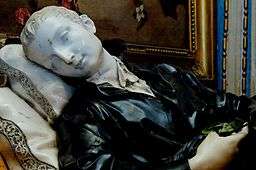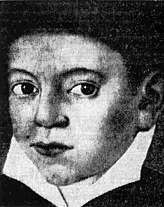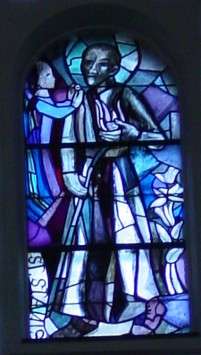Stanislaus Kostka
Stanisław Kostka S.J. (28 October 1550 – 15 August 1568) was a Polish novice of the Society of Jesus. He is venerated in the Catholic Church as Saint Stanislaus Kostka (as distinct from his namesake, the 11th-century Bishop of Kraków Stanislaus the Martyr).
Stanislaus Kostka | |
|---|---|
 | |
| Jesuit Novice | |
| Born | 28 October 1550 Rostkowo, Poland |
| Died | 15 August 1568 (aged 17) Rome, Papal States |
| Venerated in | Catholic Church |
| Beatified | 1605 |
| Canonized | 31 December 1726 |
| Major shrine | Rome |
| Feast | November 13 |
| Attributes | Lily, Jesuit habit, Jesus, Most Blessed Sacrament |
| Patronage | Jesuit novices, students, Poland, Broken Bones, Strake Jesuit College Preparatory |
He was born at Rostkowo, Przasnysz County, Poland, on 28 October 1550, and died at Rome during the night of 14–15 August 1568. He entered the Society of Jesus in Rome on his 17th birthday (28 October 1567), and is said to have foretold his death a few days before it occurred.
Biography
Family
His father was a senator of the Kingdom of Poland and Lord of Zakroczym; his mother was Małgorzata Kryska from Drobni (Margaret de Drobniy Kryska), the sister and niece of the voivodes of Masovia and the aunt of the celebrated Chancellor of Poland, Feliks Kryski (Felix Kryski)(Szczęsny Kryski). He was the second of seven children. His older brother Paweł (Paul) survived to be present at the beatification ceremony of Stanislaus in 1605. At home, the two brothers were taught with firmness, even severity; its results were their piety, modesty, temperance, and submission.
School life
On 25 July 1564, they arrived at Vienna with their tutor to attend the Jesuit college that had been opened four years before. Stanislaus was soon conspicuous among his classmates during his three years of schooling, not only for his amiability and cheerfulness of expression, but also for his growing religious fervour and piety.[1] His brother Paul said during the process of beatification that "He devoted himself so completely to spiritual things that he frequently became unconscious, especially in the church of the Jesuit Fathers at Vienna." One of the practices of devotion which he joined while at Vienna was the Congregation of St. Barbara and Our Lady, "of which he, with numbers of the pupils of the Society of Jesus" also belonged.[2] Stanislaus alleged to a fellow-member of the Society at Rome that Saint Barbara brought two angels to him during the course of a serious illness, in order to give him the Eucharist. His tutor, John Bilinski, witnessed the miracle, and though he himself did not see what Stanislaus claimed to see, he "was certain that Stanislaus was not at all out of his mind through the violence of his sickness.[2]"
Relationship with his brother
Exasperated by his younger brother's piety, Paul began to mistreat Stanislaus. Stanislaus suffered the unjust treatment with remarkable stoicism and patience, but "one night after Stanislaus had again suffered the harsh comments and blows of his brother, he turned on Paul with the words: 'Your rough treatment will end in my going away never to return, and you will have to explain my leaving to our father and mother.' Paul's sole reply was to swear violently at him."[1]
Entry into the Society of Jesus
"The thought of joining the Society of Jesus had already entered the mind of the saintly young man. It was six months, however, before he ventured to speak of this to the superiors of the Society. At Vienna they hesitated to receive him, fearing the tempest that would probably be raised by his father against the Society, which had just quieted a storm unleashed by other admissions to the Company. Stanislaus quickly grasped the situation and formed the plan of applying to the general of the Society at Rome. The distance was five hundred leagues, which had to be made on foot, without equipment or guide or any other resources but the precarious charity that might be received on the road. The prospective dangers and humiliations of such a journey, however, did not alarm his courage.
On the morning of the day on which he was to carry out his project he called his servant to him early and told him to notify his brother Paul and his tutor in the course of the morning that he would not be back that day to dinner. Then he started, exchanging the dress of gentleman for that of a mendicant, which was the only way to escape the curiosity of those he met. By nightfall Paul and the tutor comprehended that Stanislaus had fled, as he had threatened. They were seized with a fierce anger, and as the day was ended the fugitive had gained a day over them. They started to follow him, but were not able to overtake him; either their exhausted horses refused to go further, or a wheel of their carriage would break, or, as the tutor frankly declared, they had mistaken the route, having left the city by a different road from the one which Stanislaus had taken. It is noticeable that in his testimony Paul gives no explanation of his ill-luck.
Stanislaus Kostka beaten by his brother, painting by Andrea Pozzo
Stanislaus stayed for a month at Dillingen, where the provincial of that time, Saint Peter Canisius, put the young aspirant's vocation to the test by employing him in the boarding-school. He arrived 25 October 1567 in Rome. As he was greatly exhausted by the journey, the general of the order, Saint Francis Borgia, would not permit him to enter the novitiate of Saint Andrew until several days later. During the ten remaining months of his life, according to the testimony of the master of novices, Father Giulio Fazio, "he was a model and mirror of religious perfection. Notwithstanding his very delicate constitution he did not spare himself the slightest penance".[3] He had such a burning fever in his chest that he was often obliged to apply cold compresses."[1]
Death
On the evening of the feast of Saint Lawrence (10 August), Stanislaus felt a mortal weakness, made worse by a high fever, and clearly saw that his last hour had come. He wrote a letter to the Blessed Virgin begging her to call him to the skies there to celebrate with her the glorious anniversary of her Assumption (15 August).[4] His confidence in the Blessed Virgin, which had already brought him many favours, was this time again rewarded; on 15 August, towards 4:00 in the morning, while he prayed to God, to the saints, and to the Virgin Mary, he died. Many in the city proclaimed him a saint and people hastened from all parts to venerate his remains and to obtain, if possible, some relics.[5]
Sainthood
The Holy See ratified his beatification in 1605; he was canonized in 1726. St. Stanislaus is a popular saint of Poland, and many religious institutions have chosen him as the protector of their novitiates. The representations of him in art are quite varied; he is sometimes depicted receiving Holy Communion from the hands of angels, or receiving the Infant Jesus from the hands of the Virgin, or in the midst of a battle putting to flight the enemies of his country. At times he is depicted near a fountain putting a wet linen cloth on his breast. He is invoked for palpitations of the heart and for dangerous cases of illness (Cahier, "Caractéristiques des Saints").
On 15 August 2018 Pope Francis wrote to the Bishop of Płock in honor of the 450th anniversary of Stanislaus's death. In his message, Pope Francis cites a maxim of Stanislaus's: “'Ad maiora natus sum' – 'I was born for greater things'".[6]
Depiction in art

There is a portrait by Scipione Delfine, the oldest of St. Stanislaus in existence. Having probably been painted at Rome within two years of his death, it may be regarded as the best likeness. The face is strikingly Slavic, a fact that is not noticeable in his other portraits.
Additionally, Pierre Le Gros, the younger completed a marble statue of the saint in 1705.[7]

Depiction in literature

St. Thérèse of Lisieux wrote a “play” or “pious recreation” about Saint Stanislaus Kostka. Her sister Pauline had asked Thérèse to write verses and theatrical entertainment for liturgical and community festivals. "Like Stanislaus, [Therese] thought she was going to die young having accomplished nothing, 'with empty hands.' From then on, her desire to do good after her death intensified."[8]
Dedications
The following are some places dedicated to him:
San Stanislao Kostka, a church in Palermo, Sicily.
Saint Stanislaus College in Bay Saint Louis, Mississippi, a Catholic day and residential school for boys in grades 7 to 12, founded in 1854 and chartered in 1870 as Saint Stanislaus College
The novitiate of the Central and Southern Province of the Society of Jesus –Saint Stanislaus Kostka at Saint Charles College – located in Grand Coteau, Louisiana. Saint Stanislaus is also a co-patron saint (along with Saint Ignatius of Loyola, founder of the Society of Jesus) of Strake Jesuit College Preparatory in Houston, Texas, where a statue of his image was erected in front of the Parsley Center, which houses an auditorium and music facilities. In 2008, St. John's Jesuit High School and Academy of Toledo, Ohio, is one of the schools that uses his name in their house system.
St. Stanislaus Kostka Church is a parish in Pittsburgh, Pennsylvania, US.
St Stanislas de Kostka is a parish in Montreal located at 1350 Boulevard Saint-Joseph Est.
St. Stanislaus Forane Church, Mala situated at Mala, Kerala, is the only parish in India having St. Stanislaus as the patron saint. The forane church was renovated around sixty years ago.
St. Stanislaus High School in Bandra, Bombay, is a Jesuit founded in 1863.
The St. Stanislaus Institute in Ljubljana, Slovenia, an educational institution founded in 1901, is named for Stanislaus Kostka.[9]
The high school campus of the Ateneo de Manila University has a Saint Stanislaus Kostka chapel, noticeably at the center of the compound. Saint Kostka is also the patron saint of the Ateneo de Manila High School. At the Ateneo de Davao University, the grade school chapel, adorned with stained glass depictions of the life of Jesus Christ, was named after him.
Saint Stanislaus Kostka is the patron saint of the attendees of Oblates of Saint Joseph Minor Seminary (a high school-level seminary in San Jose, Batangas, Philippines), as well as Manukan, Zamboanga del Norte Philippines.
One of the junior campuses of the Jesuit school Xavier College in Melbourne, Australia, is named Kostka Hall; Boston College also has named one of their freshman dorms Kostka Hall. He is also a patron of the minor seminarians of the Oblates of St. Joseph Minor Seminary.
Beaumont College, formerly a public school in Berkshire, was dedicated to Saint Stanislaus.
Saint Stanislaw Kostka is also the patron saint of The Polish Saturday School in Manchester, Lancashire, which was founded in 1949 by the Manchester Polish Ex-Combatants Association and which supports the school to this day. The Polish name of the school is Polska Szkoła Przedmiotów Ojczystych im. św. Stanisława Kostki w Manchesterze.
Saint Stanislaus High and Junior School in Gdynia is an independent private school located in Gdynia, Poland.[10]
A school in Quezon City Philippines has a name of Kostka School of Quezon City which is named after St. Stanislaus Kostka.
Also, a public school in Guyana is named after him, St. Stanislaus College.
St. Stanislaus Kostka Church (Chicago) opened in 1867. By 1897, St. Stanislaus Kostka Parish was the largest parish in the United States with 8,000 families, totaling 40,000 people. There were twelve Masses each Sunday: six Masses in the upper church and another six Masses in the lower church. St. Stanislaus Kostka Parish is considered the mother church of the many Polish parishes.
On November 10, 2011, the Church of Saint Stanislaus Kostka in Winona, Minnesota, was elevated by Pope Benedict XVI to the status of Minor Basilica, making it the first ever Basilica of Saint Stanislaus Kostka.
The Brooklyn Diocese has two parishes and schools named after St. Stanislaus Kostka – one in Maspeth, Queens, and one in Greenpoint, Brooklyn.
St. Stanislaus Church in Winchester, New Hampshire, US.
St Stanislaus' College, in the rural city of Bathurst, New South Wales Australia.
References
- Holweck, F. G., A Biographical Dictionary of the Saints. St. Louis, MO: B. Herder Book Co., 1924.
- This account has been drawn almost exclusively from the depositions of witnesses cited for the process of canonization of Stanislaus (cf. Archivio della Postulazione generale d. C. d. G., Roma).
- The Catholic Encyclopedia, Vol. 14. The Encyclopedia Press. 1912.
- Coleridge, Henry James (1893). The Story of St. Stanislaus Kostka: Of the Society of Jesus. Burnes and Oates.
- "Monument hist. Societatis Jesu, Sanctus Franciscus Borgia", IV, 635
- "Monument hist. Societatis Jesu, Sanctus Franciscus Borgia", IV, 636
- "Monument hist. Societatis Jesu, Sanctus Franciscus Borgia", IV, 637
- "MESSAGE OF THE HOLY FATHER FRANCIS FOR THE 450TH ANNIVERSARY OF THE DEATH OF SAINT STANISLAUS KOSTKA". Retrieved 9 December 2018.
- "The Death of St Stanislas Kostka by LE GROS, Pierre the Younger". www.wga.hu. Retrieved 2018-12-09.
- The Plays of Saint Therese of Lisieux: "Pious Recreations". ICS Publications. 2008. p. 330.
- Koneczny, Feliks. 1918. Polska w kulturze powszechnej. Kraków: Krakowska Ekspozytura Biura Patronatu dla Spółek Oszczęd i Pożyczek, p. 137.
- "Zespół Szkół Jezuitów" (in Polish). Jezuici.pl. Retrieved 2014-05-23.
![]()
External links
| Wikimedia Commons has media related to Stanislaus Kostka. |
